安徽医科大学:《临床药理学 Clinical Pharmacology》课程教学资源(授课教案,英文版)New drugs development
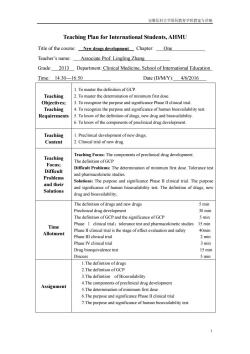
安徽医科大学国际教育学院教案与讲稿 Teaching Plan for International Students,AHMU Title of the course:New drugs development Chapter:One Teacher's name:Associate Prof.Lingling Zhang Grade:2013 Department:Clinical Medicine,School of International Education Time:14:30-16:50 Date(D/M/Y):4/6/2016 1.To master the definition of GCP. Teaching 2.To master the determination of minimum first dose. Objectives; 3.To recognize the purpose and significance Phase II clinical trial. Teaching 4.To recognize the purpose and significance of human bioavailability test. Requirements 5.To know of the definition of drugs,new drug and bioavailability. 6.To know of the components of preclinical drug development. Teaching 1.Preclinical development of new drugs; Content 2.Clinical trial of new drug. Teaching Teaching Focus:The components of preclinical drug development The definition of GCP Focus; Difficult Problems:The determination of minimum first dose.Tolerance test Difficult and pharmacokinetic studies. Problems Solutions:The purpose and significance Phase II clinical trial.The purpose and their and significance of human bioavailability test.The definition of drugs,new Solutions drug and bioavailability; The definition of drugs and new drugs 5 min Preclinical drug development 30min The definition of GCP and the significance of GCP 5min Phase I clinical trial:tolerance test and pharmacokinetic studies 15 min Time Phase II clinical trial is the stage of effect evaluation and safety 40min Allotment Phase III clinical trial 2 min Phase IV clinical trial 3min Drug bioequivalence test 15 min Discuss 5min 1.The definition of drugs 2.The definition of GCP 3.The definition of Bioavailability 4.The components of preclinical drug development Assignment 5.The determination of minimum first dose 6.The purpose and significance Phase II clinical trial 7.The purpose and significance of human bioavailability test 1
安徽医科大学国际教育学院教案与讲稿 1 Teaching Plan for International Students, AHMU Title of the course: New drugs development Chapter: One Teacher’s name: Associate Prof. Lingling Zhang Grade: 2013 Department: Clinical Medicine, School of International Education Time: 14:30—16:50 Date (D/M/Y): 4/6/2016 Teaching Objectives; Teaching Requirements 1. To master the definition of GCP. 2. To master the determination of minimum first dose. 3. To recognize the purpose and significance Phase II clinical trial. 4. To recognize the purpose and significance of human bioavailability test. 5. To know of the definition of drugs, new drug and bioavailability. 6. To know of the components of preclinical drug development. Teaching Content 1. Preclinical development of new drugs; 2. Clinical trial of new drug. Teaching Focus; Difficult Problems and their Solutions Teaching Focus: The components of preclinical drug development. The definition of GCP Difficult Problems: The determination of minimum first dose. Tolerance test and pharmacokinetic studies. Solutions: The purpose and significance Phase II clinical trial. The purpose and significance of human bioavailability test. The definition of drugs, new drug and bioavailability; Time Allotment The definition of drugs and new drugs 5 min Preclinical drug development 30 min The definition of GCP and the significance of GCP 5 min Phase Ⅰ clinical trial:tolerance test and pharmacokinetic studies 15 min Phase II clinical trial is the stage of effect evaluation and safety 40min Phase III clinical trial 2 min Phase IV clinical trial 3 min Drug bioequivalence test 15 min Discuss 5 min Assignment 1.The definition of drugs 2.The definition of GCP 3.The definition of Bioavailability 4.The components of preclinical drug development 5.The determination of minimum first dose 6.The purpose and significance Phase II clinical trial 7.The purpose and significance of human bioavailability test
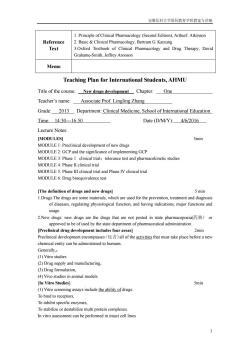
安微医科大学国际教育学院教案与讲稿 1.Principle of Clinical Pharmacology(Second Edition);ArthurJ.Atkinson Reference 2.Basic Clinical Pharmacology;Bertram G.Katzung Text 3.Oxford Textbook of Clinical Pharmacology and Drug Therapy;David Grahame-Smith,Jeffrey Aronson Memo Teaching Plan for International Students,AHMU Title of the course:New drugs development Chapter:One Teacher's name: Associate Prof.Lingling Zhang Grade:2013 Department:Clinical Medicine,School of International Education Time:14:30-16:50 Date(DM/Y):4/6/2016 Lecture Notes: [MODULES] 5min MODULE 1:Preclinical development of new drugs MODULE 2:GCP and the significance of implementing GCP MODULE 3:Phase I clinical trial:tolerance test and pharmacokinetic studies MODULE 4:Phase II clinical trial MODULE 5:Phase III clinical trial and Phase IV clinical trial MODULE 6:Drug bioequivalence test [The definition of drugs and new drugs] 5 min 1.Drugs:The drugs are some materials,which are used for the prevention,treatment and diagnosis of diseases,regulating physiological function,and having indications,major functions and usage. 2.New drugs:new drugs are the drugs that are not posted in state pharmacopoeia()or approved to be of used by the state department of pharmaceutical administration. [Preclinical drug development includes four areas] 2min Preclinical development encompasses(all of the activities that must take place before a new chemical entity can be administered to humans. Generally,: (1)Vitro studies (2)Drug supply and manufacturing, (3)Drug formulation, (4)Vivo studies in animal models. [In Vitro Studies] 5min (1)Vitro screening assays include the ability of drugs: To bind to receptors, To inhibit specific enzymes, To stabilize or destabilize multi protein complexes. In vitro assessment can be performed in intact cell lines 2
安徽医科大学国际教育学院教案与讲稿 2 Reference Text 1. Principle of Clinical Pharmacology (Second Edition); ArthurJ. Atkinson 2. Basic & Clinical Pharmacology; Bertram G. Katzung 3.Oxford Textbook of Clinical Pharmacology and Drug Therapy; David Grahame-Smith, Jeffrey Aronson Memo Teaching Plan for International Students, AHMU Title of the course: New drugs development Chapter: One Teacher’s name: Associate Prof. Lingling Zhang Grade: 2013 Department: Clinical Medicine, School of International Education Time: 14:30—16:50 Date (D/M/Y): 4/6/2016 Lecture Notes: [MODULES] 5min MODULE 1: Preclinical development of new drugs MODULE 2: GCP and the significance of implementing GCP MODULE 3: PhaseⅠ clinical trial:tolerance test and pharmacokinetic studies MODULE 4: Phase II clinical trial MODULE 5: Phase III clinical trial and Phase IV clinical trial MODULE 6: Drug bioequivalence test [The definition of drugs and new drugs] 5 min 1.Drugs:The drugs are some materials, which are used for the prevention, treatment and diagnosis of diseases, regulating physiological function, and having indications, major functions and usage. 2.New drugs: new drugs are the drugs that are not posted in state pharmacopoeia(药典) or approved to be of used by the state department of pharmaceutical administration. [Preclinical drug development includes four areas] 2min Preclinical development encompasses(包含)all of the activities that must take place before a new chemical entity can be administered to humans. Generally,: (1) Vitro studies (2) Drug supply and manufacturing, (3) Drug formulation, (4) Vivo studies in animal models. [In Vitro Studies] 5min (1) Vitro screening assays include the ability of drugs: To bind to receptors, To inhibit specific enzymes, To stabilize or destabilize multi protein complexes. In vitro assessment can be performed in intact cell lines
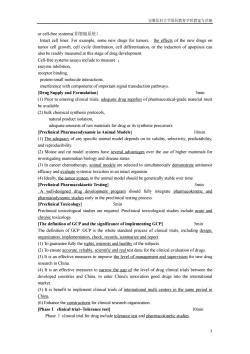
安徽医科大学国际教育学院教案与讲稿 or cell--free systems(非细胞系统) Intact cell lines:For example,some new drugs for tumors,the effects of the new drugs on tumor cell growth,cell cycle distribution,cell differentiation,or the induction of apoptosis can also be readily measured at this stage of drug development. Cell-free systems assays include to measure enzyme inhibition, receptor binding, protein-small molecule interactions, interference with components of important signal transduction pathways. [Drug Supply and Formulation] 3min (1)Prior to entering clinical trials,adequate drug supplies of pharmaceutical-grade material must be available. (2)bulk chemical synthesis protocols, natural product isolation, adequate amounts of raw materials for drug or its synthetic precursors [Preclinical Pharmacodynamic in Animal Models] 10min (1)The adequacy of any specific animal model depends on its validity,selectivity,predictability, and reproducibility. (2)Mouse and rat model systems have several advantages over the use of higher mammals for investigating mammalian biology and disease states. (3)In cancer chemotherapy,animal models are selected to simultaneously demonstrate antitumor efficacy and evaluate systemic toxicities in an intact organism. (4)Ideally,the tumor system in the animal model should be genetically stable over time. [Preclinical Pharmacokinetic Testing] 5min A well-designed drug development program should fully integrate pharmacokinetic and pharmacodynamic studies early in the preclinical testing process. Preclinical Toxicology] 5min Preclinical toxicological studies are required.Preclinical toxicological studies include acute and chronic toxicology [The definition of GCP and the significance of implementing GCP] 5min The definition of GCP GCP is the whole standard process of clinical trials,including design, organization,implementation,check,records,summarize and report. (1)To guarantee fully the rights,interests and healthy of the subjects. (2)To ensure accurate reliable scientific and real test data,for the clinical evaluation of drugs. (3)It is an effective measures to improve the level of management and supervision for new drug research in China. (4)It is an effective measures to narrow the gap of the level of drug clinical trials between the developed countries and China,to enter China's innovation good drugs into the international market. (5)It is benefit to implement clinical trials of international multi centers in the same period in China. (6)Enhance the constructions for clinical research organization. [Phase I clinical trial--Tolerance test] 10min Phase I clinical trial for drug include tolerance test and pharmacokinetic studies. 3
安徽医科大学国际教育学院教案与讲稿 3 or cell-free systems(非细胞系统). Intact cell lines: For example, some new drugs for tumors, the effects of the new drugs on tumor cell growth, cell cycle distribution, cell differentiation, or the induction of apoptosis can also be readily measured at this stage of drug development. Cell-free systems assays include to measure : enzyme inhibition, receptor binding, protein-small molecule interactions, interference with components of important signal transduction pathways. [Drug Supply and Formulation] 3min (1) Prior to entering clinical trials, adequate drug supplies of pharmaceutical-grade material must be available. (2) bulk chemical synthesis protocols, natural product isolation, adequate amounts of raw materials for drug or its synthetic precursors. [Preclinical Pharmacodynamic in Animal Models] 10min (1) The adequacy of any specific animal model depends on its validity, selectivity, predictability, and reproducibility. (2) Mouse and rat model systems have several advantages over the use of higher mammals for investigating mammalian biology and disease states. (3) In cancer chemotherapy, animal models are selected to simultaneously demonstrate antitumor efficacy and evaluate systemic toxicities in an intact organism. (4) Ideally, the tumor system in the animal model should be genetically stable over time. [Preclinical Pharmacokinetic Testing] 5min A well-designed drug development program should fully integrate pharmacokinetic and pharmacodynamic studies early in the preclinical testing process. [Preclinical Toxicology] 5min Preclinical toxicological studies are required. Preclinical toxicological studies include acute and chronic toxicology. [The definition of GCP and the significance of implementing GCP] 5min The definition of GCP :GCP is the whole standard process of clinical trials, including design, organization, implementation, check, records, summarize and report. (1) To guarantee fully the rights, interests and healthy of the subjects. (2) To ensure accurate, reliable, scientific and real test data, for the clinical evaluation of drugs. (3) It is an effective measures to improve the level of management and supervision for new drug research in China. (4) It is an effective measures to narrow the gap of the level of drug clinical trials between the developed countries and China, to enter China's innovation good drugs into the international market. (5) It is benefit to implement clinical trials of international multi centers in the same period in China. (6) Enhance the constructions for clinical research organization. [PhaseⅠ clinical trial--Tolerance test] 10min Phase clinical trial for dru Ⅰ g include tolerance test and pharmacokinetic studies
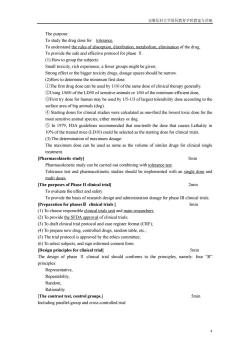
安徽医科大学国际教育学院教案与讲稿 The purpose: To study the drug dose for tolerance, To understand the rules of absorption,distribution,metabolism,elimination of the drug, To provide the safe and effective protocol for phase II. (1)How to group the subjects: Small toxicity,rich experience,a fewer groups might be given: Strong effect or the bigger toxicity drugs,dosage spaces should be narrow. (2)How to determine the minimum first dose: DThe first drug dose can be used by 1/10 of the same dose of clinical therapy generally 2Using 1/600 of the LD50 of sensitive animals or 1/60 of the minimum efficient dose, 3First try dose for human may be used by 1/5-1/3 of largest tolerability dose according to the surface area of big animals(dog). 4 Starting doses for clinical studies were calculated as one-third the lowest toxic dose for the most sensitive animal species,either monkey or dog. 5 In 1979,FDA guidelines recommended that one-tenth the dose that causes Lethality in 10%of the treated mice (LD10)could be selected as the starting dose for clinical trials. (3)The determination of maximum dosage: The maximum dose can be used as same as the volume of similar drugs for clinical single treatment. [Pharmacokinetic study] 5min Pharmacokinetic study can be carried out combining with tolerance test. Tolerance test and pharmacokinetic studies should be implemented with an single dose and multi doses. [The purposes of Phase II clinical triall 2min To evaluate the effect and safety. To provide the basis of research design and administration dosage for phase IlI clinical trials. Preparation for phasesⅡclinical trials】 3min (1)To choose responsible clinical trials unit and main researchers (2)To provide the SFDA approval of clinical trials, (3)To draft clinical trial protocol and case register format(CRF); (4)To prepare new drug,controlled drugs,random table,etc.; (5)The trial protocol is approved by the ethics committee; (6)To select subjects,and sign informed consent form. [Design principles for clinical trial] 5min The design of phase II clinical trial should conforms to the principles,namely:four "R" principles: Representative, Repeatability, Random, Rationality. The contrast test,control groups. 5min Including parallel-group and cross controlled trial 4
安徽医科大学国际教育学院教案与讲稿 4 The purpose: To study the drug dose for tolerance, To understand the rules of absorption, distribution, metabolism, elimination of the drug, To provide the safe and effective protocol for phase . Ⅱ (1) How to group the subjects: Small toxicity, rich experience, a fewer groups might be given; Strong effect or the bigger toxicity drugs, dosage spaces should be narrow. (2)How to determine the minimum first dose: ①The first drug dose can be used by 1/10 of the same dose of clinical therapy generally. ②Using 1/600 of the LD50 of sensitive animals or 1/60 of the minimum efficient dose, ③First try dose for human may be used by 1/5-1/3 of largest tolerability dose according to the surface area of big animals (dog). ④ Starting doses for clinical studies were calculated as one-third the lowest toxic dose for the most sensitive animal species, either monkey or dog. ⑤ In 1979, FDA guidelines recommended that one-tenth the dose that causes Lethality in 10% of the treated mice (LD10) could be selected as the starting dose for clinical trials. (3) The determination of maximum dosage: The maximum dose can be used as same as the volume of similar drugs for clinical single treatment. [Pharmacokinetic study] 5min Pharmacokinetic study can be carried out combining with tolerance test. Tolerance test and pharmacokinetic studies should be implemented with an single dose and multi doses. [The purposes of Phase II clinical trial] 2min To evaluate the effect and safety. To provide the basis of research design and administration dosage for phase III clinical trials. [Preparation for phasesⅡ clinical trials ] 3min (1) To choose responsible clinical trials unit and main researchers (2) To provide the SFDA approval of clinical trials; (3) To draft clinical trial protocol and case register format (CRF); (4) To prepare new drug, controlled drugs, random table, etc.; (5) The trial protocol is approved by the ethics committee; (6) To select subjects, and sign informed consent form. [Design principles for clinical trial] 5min The design of phase Ⅱ clinical trial should conforms to the principles, namely: four “R” principles: Representative, Repeatability, Random, Rationality. [The contrast test, control groups.] 5min Including parallel-group and cross controlled trial
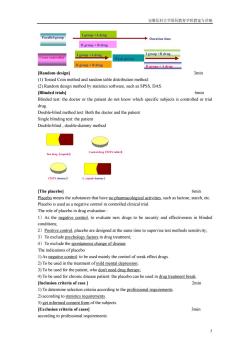
安微医科大学国际教育学院教案与讲稿 Parallel-group I group +A drug ◆Duration time II group +B drug I group +A drug I group +B drug Cross controlled Wash perind II group+B drug II group +A drug [Random design] 3min (1)Tossed Coin method and random table distribution method: (2)Random design method by statistics software,such as SPSS,DAS [Blinded trials 6min Blinded test:the doctor or the patient do not know which specific subjects is controlled or trial drug. Double-blind method test:Both the doctor and the patient Single blinding test:the patient Double-blind,double-dummy method Control drug (MTX tablet) Test drug (capsule) (MTX dummy) capsule dummy [The placebo] 6min Placebo means the substances that have no pharmacological activities,such as lactose,starch,etc. Placebo is used as a negative control in controlled clinical trial. The role of placebo in drug evaluation: 1)As the negative control,to evaluate new drugs to be security and effectiveness in blinded conditions; 2)Positive control,placebo are designed at the same time to supervise test methods sensitivity; 3)To exclude psychology factors in drug treatment, 4)To exclude the spontaneous change of disease. The indications of placebo 1)As negative control:to be used mainly the control of weak effect drugs. 2)To be used in the treatment of mild mental depression; 3)To be used for the patient,who don't need drug therapy; 4)To be used for chronic disease patient:the placebo can be used in drug treatment break. [Inclusion criteria of case l 2min 1)To determine selection criteria according to the professional requirements. 2)according to statistics requirements. 3)get informed consent form of the subjects. [Exclusion criteria of cases] 3min according to professional requirements: 5
安徽医科大学国际教育学院教案与讲稿 5 [Random design] 3min (1) Tossed Coin method and random table distribution method: (2) Random design method by statistics software, such as SPSS, DAS. [Blinded trials] 6min Blinded test: the doctor or the patient do not know which specific subjects is controlled or trial drug. Double-blind method test: Both the doctor and the patient Single blinding test: the patient Double-blind , double-dummy method [The placebo] 6min Placebo means the substances that have no pharmacological activities, such as lactose, starch, etc. Placebo is used as a negative control in controlled clinical trial. The role of placebo in drug evaluation : 1)As the negative control, to evaluate new drugs to be security and effectiveness in blinded conditions; 2)Positive control, placebo are designed at the same time to supervise test methods sensitivity; 3)To exclude psychology factors in drug treatment; 4)To exclude the spontaneous change of disease. The indications of placebo 1) As negative control: to be used mainly the control of weak effect drugs. 2) To be used in the treatment of mild mental depression; 3) To be used for the patient, who don't need drug therapy; 4) To be used for chronic disease patient: the placebo can be used in drug treatment break. [Inclusion criteria of case ] 2min 1) To determine selection criteria according to the professional requirements. 2) according to statistics requirements. 3) get informed consent form of the subjects. [Exclusion criteria of cases] 3min according to professional requirements: Parallel-group Cross controlled I group +A drug II group + B drug Duration time I group +A drug II group + B drug Wash period I group +B drug II group + A drug Test drug(capsule) Control drug(MTX tablet) (MTX dummy) ( capsule dummy)
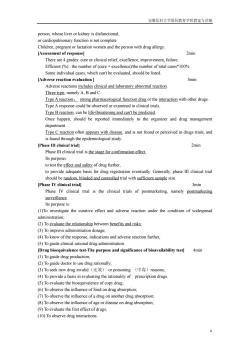
安徽医科大学国际教育学院教案与讲稿 person,whose liver or kidney is disfunctional, or cardiopulmonary function is not complete. Children,pregnant or lactation women and the person with drug allergy. [Assessment of responsel 2min There are 4 grades:cure or clinical relief,excellence,improvement,failure. Efficient(%):the number of(cure +excellence)/the number of total cases*100% Some individual cases,which can't be evaluated,should be listed. [Adverse reaction evaluation 3min Adverse reactions includes clinical and laboratory abnormal reaction. Three type,namely A,B and C. Type A reaction:strong pharmacological function drug or the interaction with other drugs. Type A response could be observed or examined in clinical trials. Type B reaction,can be life-threatening and can't be predicted. Once happen,should be reported immediately to the organizer and drug management department. Type C reaction often appears with disease,and is not found or perceived in drugs trials,and is found through the epidemiological study. Phase III clinical triall 2min Phase IlI clinical trial is the stage for confirmation effect. Its purpose: to test the effect and safety of drug further, to provide adequate basis for drug registration eventually.Generally,phase III clinical trial should be random,blinded and controlled trial with sufficient sample size. [Phase IV clinical trial] 3min Phase IV clinical trial is the clinical trials of postmarketing,namely postmarketing surveillance Its purpose is: (1)To investigate the curative effect and adverse reaction under the condition of widespread administration; (2)To evaluate the relationship between benefits and risks; (3)To improve administration dosage; (4)To know of the response,indications and adverse reaction further, (5)To guide clinical rational drug administration. [Drug bioequivalence test-The purpose and significance of bioavailability test] 4min (1)To guide drug production; (2)To guide doctor to use drug rationally, (3)To seek new drug invalid(无效)or poisoning(中毒)reasons, (4)To provide a basis in evaluating the rationality of prescription drugs. (5)To evaluate the bioequivalence of copy drug; (6)To observe the influence of food on drug absorption; (7)To observe the influence of a drug on another drug absorption; (8)To observe the influence of age or disease on drug absorption; (9)To evaluate the first effect of drugs; (10)To observe drug interactions. 6
安徽医科大学国际教育学院教案与讲稿 6 person, whose liver or kidney is disfunctional, or cardiopulmonary function is not complete. Children, pregnant or lactation women and the person with drug allergy. [Assessment of response] 2min There are 4 grades: cure or clinical relief, excellence, improvement, failure. Efficient (%) : the number of (cure + excellence)/the number of total cases*100% Some individual cases, which can't be evaluated, should be listed. [Adverse reaction evaluation ] 3min Adverse reactions includes clinical and laboratory abnormal reaction. Three type, namely A, B and C. Type A reaction: strong pharmacological function drug or the interaction with other drugs. Type A response could be observed or examined in clinical trials. Type B reaction, can be life-threatening and can't be predicted. Once happen, should be reported immediately to the organizer and drug management department. Type C reaction often appears with disease, and is not found or perceived in drugs trials, and is found through the epidemiological study. [Phase III clinical trial] 2min Phase III clinical trial is the stage for confirmation effect. Its purpose: to test the effect and safety of drug further, to provide adequate basis for drug registration eventually. Generally, phase III clinical trial should be random, blinded and controlled trial with sufficient sample size. [Phase IV clinical trial] 3min Phase IV clinical trial is the clinical trials of postmarketing, namely postmarketing surveillance. Its purpose is: (1)To investigate the curative effect and adverse reaction under the condition of widespread administration; (2) To evaluate the relationship between benefits and risks; (3) To improve administration dosage; (4) To know of the response, indications and adverse reaction further, (5) To guide clinical rational drug administration. [Drug bioequivalence test-The purpose and significance of bioavailability test] 4min (1) To guide drug production; (2) To guide doctor to use drug rationally; (3) To seek new drug invalid(无效) or poisoning (中毒)reasons; (4) To provide a basis in evaluating the rationality of prescription drugs. (5) To evaluate the bioequivalence of copy drug; (6) To observe the influence of food on drug absorption; (7) To observe the influence of a drug on another drug absorption; (8) To observe the influence of age or disease on drug absorption; (9) To evaluate the first effect of drugs; (10) To observe drug interactions
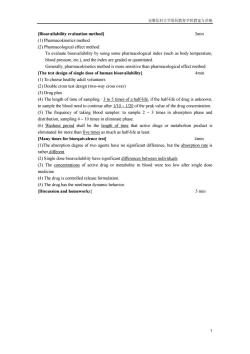
安徽医科大学国际教育学院教案与讲稿 Bioavailability evaluation methodl 3min (1)Pharmacokinetics method (2)Pharmacological effect method: To evaluate bioavailability by using some pharmacological index(such as body temperature, blood pressure,etc.),and the index are graded or quantitated. Generally,pharmacokinetics method is more sensitive than pharmacological effect method. [The test design of single dose of human bioavailability] 4min (1)To choose healthy adult volunteers (2)Double cross test design(two-way cross over) (3)Drug plan (4)The length of time of sampling:3 to 5 times of a half-life,if the half-life of drug is unknown, to sample the blood need to continue after 1/10~1/20 of the peak value of the drug concentration. (5)The frequency of taking blood samples:to sample 2 ~3 times in absorption phase and distribution,sampling 4~10 times in eliminate phase. (6)Washout period shall be the length of time that active drugs or metabolism product is eliminated for more than five times as much as half-life at least. [Many times for bioequivalence test] 4min (1)The absorption degree of two agents have no significant difference,but the absorption rate is rather different. (2)Single dose bioavailability have significant differences between individuals (3)The concentrations of active drug or metabolite in blood were too low after single dose medicine (4)The drug is controlled release formulation. (5)The drug has the nonlinear dynamic behavior. [Discussion and homeworks] 5 min 7
安徽医科大学国际教育学院教案与讲稿 7 [Bioavailability evaluation method] 3min (1) Pharmacokinetics method (2) Pharmacological effect method: To evaluate bioavailability by using some pharmacological index (such as body temperature, blood pressure, etc.), and the index are graded or quantitated. Generally, pharmacokinetics method is more sensitive than pharmacological effect method. [The test design of single dose of human bioavailability] 4min (1) To choose healthy adult volunteers (2) Double cross test design (two-way cross over) (3) Drug plan (4) The length of time of sampling : 3 to 5 times of a half-life, if the half-life of drug is unknown, to sample the blood need to continue after 1/10 ~ 1/20 of the peak value of the drug concentration. (5) The frequency of taking blood samples: to sample 2 ~ 3 times in absorption phase and distribution, sampling 4 ~ 10 times in eliminate phase. (6) Washout period shall be the length of time that active drugs or metabolism product is eliminated for more than five times as much as half-life at least. [Many times for bioequivalence test] 4min (1)The absorption degree of two agents have no significant difference, but the absorption rate is rather different. (2) Single dose bioavailability have significant differences between individuals. (3) The concentrations of active drug or metabolite in blood were too low after single dose medicine. (4) The drug is controlled release formulation. (5) The drug has the nonlinear dynamic behavior. [Discussion and homeworks] 5 min
按次数下载不扣除下载券;
注册用户24小时内重复下载只扣除一次;
顺序:VIP每日次数-->可用次数-->下载券;
- 安徽医科大学:《临床药理学 Clinical Pharmacology》课程教学资源(授课教案,英文版)Charpter 24 Drug therapy in the elderly.pdf
- 安徽医科大学:《临床药理学 Clinical Pharmacology》课程教学资源(授课教案,英文版)Charpter 23 Drug therapy in neonates and pediatric patients.pdf
- 安徽医科大学:《临床药理学 Clinical Pharmacology》课程教学资源(授课教案,英文版)Charpter 22 Drug therapy in pregant and nursing women.pdf
- 安徽医科大学:《临床药理学 Clinical Pharmacology》课程教学资源(授课教案,英文版)Time Course of Drug Response.pdf
- 安徽医科大学:《临床药理学 Clinical Pharmacology》课程教学资源(授课教案,英文版)Dose-effect and concentration-effect analysis.pdf
- 安徽医科大学:《临床药理学 Clinical Pharmacology》课程教学资源(授课教案,英文版)Physiological and laboratory markers of drug effect.pdf
- 安徽医科大学:《临床药理学 Clinical Pharmacology》课程教学资源(授课教案,英文版)Chapter 16 Drug Toxicity and Adverse Drug Reactions.pdf
- 安徽医科大学:《临床药理学 Clinical Pharmacology》课程教学资源(授课教案,英文版)Chapter 15 Drug Interactions.pdf
- 安徽医科大学:《临床药理学 Clinical Pharmacology》课程教学资源(授课教案,英文版)Chapter 13.pdf
- 安徽医科大学:《临床药理学 Clinical Pharmacology》课程教学资源(授课教案,英文版)Chapter One.pdf
- 安徽医科大学:《临床药理学 Clinical Pharmacology》课程教学资源(授课教案,英文版)Chapter One Introduction to Clinical Pharmacology.pdf
- 江苏第二师范学院:一种用于制药压片生产的虚拟仿真平台.pdf
- 安徽医科大学:《药剂学》课程教学资源(各章作业习题,含参考答案).pdf
- 安徽医科大学:《药剂学》课程教学资源(教学大纲).pdf
- 长治医学院:《药理学》课程思政融入实践.pdf
- 电子科技大学医学院:《高级临床药学实践 Advanced clinical pharmaceutical practice》课程教学资源(课件讲稿)18 新冠肺炎防控中药学专业担当.pdf
- 电子科技大学医学院:《高级临床药学实践 Advanced clinical pharmaceutical practice》课程教学资源(课件讲稿)17 抗菌药物PK、PD与临床合理使用 Antibacterial PK/PD and rational clinical use.pdf
- 电子科技大学医学院:《高级临床药学实践 Advanced clinical pharmaceutical practice》课程教学资源(课件讲稿)16 围手术期抗菌药物合理使用及管理经验分享.pdf
- 电子科技大学医学院:《高级临床药学实践 Advanced clinical pharmaceutical practice》课程教学资源(课件讲稿)15 抗菌药物合理使用——从政策到专业 Rational Use of Antibiotics - From Policy to Profession.pdf
- 电子科技大学医学院:《高级临床药学实践 Advanced clinical pharmaceutical practice》课程教学资源(课件讲稿)14 药物咨询案例分析——慢病管理实践.pdf
- 安徽医科大学:《临床药理学 Clinical Pharmacology》课程教学资源(课件讲稿,英文版)临床药理学概论 Introduction to clinlcal pharmacology(主讲:魏伟).pdf
- 安徽医科大学:《临床药理学 Clinical Pharmacology》课程教学资源(课件讲稿,英文版)药物作用评价 Assessment of drug effects(主讲:汪庆童).pdf
- 安徽医科大学:《临床药理学 Clinical Pharmacology》课程教学资源(课件讲稿,英文版)新药研发 New drugs development(主讲:(张玲玲).pdf
- 安徽医科大学:《临床药理学 Clinical Pharmacology》课程教学资源(课件讲稿,英文版)Clinical Pharmacogenetics Drug interaction Drug toxicology(主讲:常艳).pdf
- 安徽医科大学:《临床药理学 Clinical Pharmacology》课程教学资源(课件讲稿,英文版)Clinical Pharmacokinetics.pdf
- 安徽医科大学:《临床药理学 Clinical Pharmacology》课程教学资源(课件讲稿,英文版)新生儿及儿童合理用药 Drug Therapy in Neonates and children.pdf
- 安徽医科大学:《临床药理学 Clinical Pharmacology》课程教学资源(课件讲稿,英文版)特殊人群的药物治疗学 Drug Therapy in Pregnant.pdf
- 安徽医科大学:《临床药理学 Clinical Pharmacology》课程教学资源(课件讲稿,英文版)老年人药物治疗 Drug therapy in the elderly.pdf
- 温州医科大学:《药理学》课程教学资源(练习题,人卫专科八版,含答案).pdf
- 温州医科大学:临床医学专业《药理学》课程教学资源(练习资料,人卫九版,含答案).doc
- 温州医科大学:《药理学》课程教学资源(护理学专业,练习资料,人卫九版,含答案).doc
- 甘肃农业大学:《药用植物栽培学》课程教学资源(教学大纲,打印版).pdf
- 甘肃农业大学:《药用植物栽培学》课程教学资源(理论教案,打印版).pdf
- 甘肃农业大学:《药用植物栽培学》课程教学资源(实验教案,打印版).pdf
- 西南交通大学:《制药工艺学 Pharmaceutical Technology》课程教学资源(课件讲稿)化学制药工艺安全性(主讲:陆群).pdf
- 西南交通大学:《制药工艺学 Pharmaceutical Technology》课程教学资源(课件讲稿)生物制药工艺——青霉素的发酵生产工艺.pdf
- 西南交通大学:《制药工艺学 Pharmaceutical Technology》课程教学资源(课件讲稿)重组人干扰素生产工艺.pdf
- 西南交通大学:《制药工艺学 Pharmaceutical Technology》课程教学资源(课件讲稿)奥美拉唑的生产工艺原理.pdf
- 上海中医药大学:课程教学大纲汇编合集(2017年版)教学大纲(外语中心).pdf
- 河南大学:《药理学》课程教学资源(教学大纲)药理学教学大纲(理论).pdf
